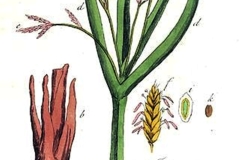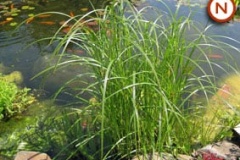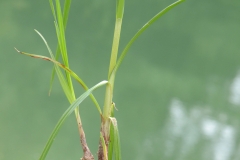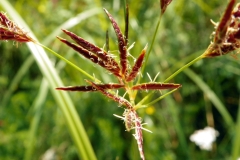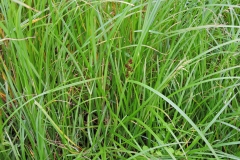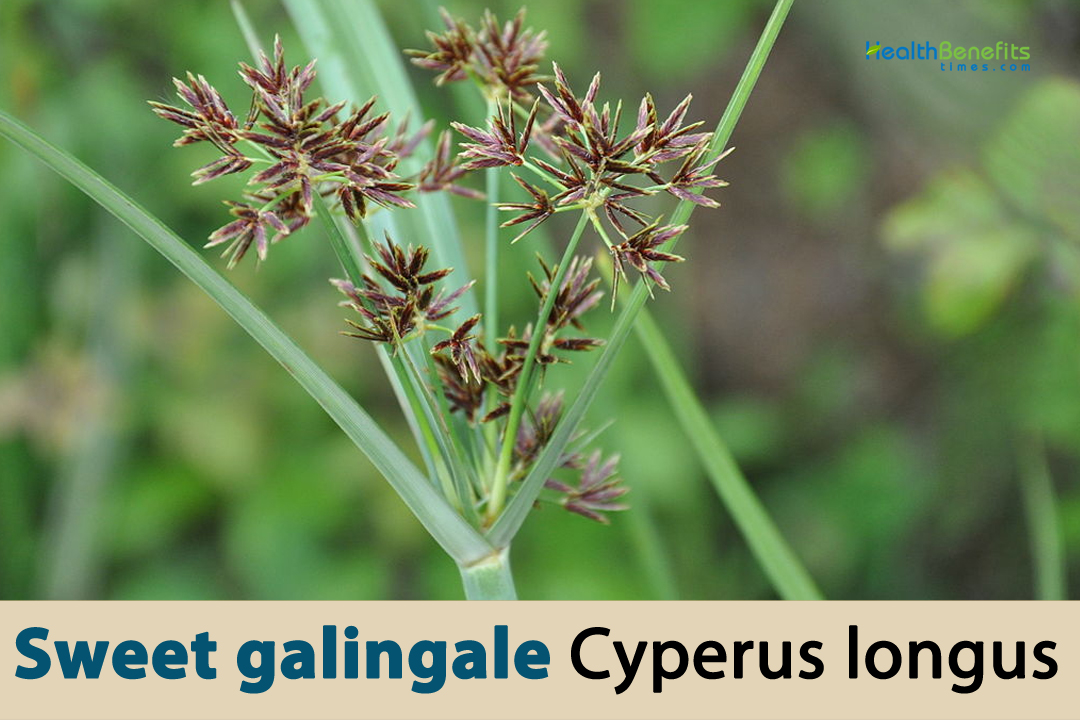 Sweet galingale or galingale scientifically known as Cyperus longus is a perennial herbaceous plant in the genus Cyperus which contains between 764 and 901 species and belongs to the family of the Cyperaceae (Sedge Family). The type species of the genus is Cyperus esculentus. The plant is native to Africa, southern Europe, the Indian subcontinent and western Asia. It is also found in western France, south Wales and southern England, where it may or not originally be native. It has also been introduced to Tristan da Cunha and Western Australia. Sweet galingale is often grown for its aromatic rhizomes, which are used in culinary and medicinal applications. Some of the popular common names of the plants are Nut grass, Earth nut, Yellow nut sedge, Chufa sedge, Water grass, Earth almond, Coco-grass, Nut grass sedge, Yellow nut grass, Tiger nut, Water nut grass, Ground almond, Yellow nutgrass sedge, Rush nut, Tuberous sedge, Purple nutsedge, Edible rush, Earth chestnut, Nut sedge, Nut sedge grass and Red nut sedge.
Sweet galingale or galingale scientifically known as Cyperus longus is a perennial herbaceous plant in the genus Cyperus which contains between 764 and 901 species and belongs to the family of the Cyperaceae (Sedge Family). The type species of the genus is Cyperus esculentus. The plant is native to Africa, southern Europe, the Indian subcontinent and western Asia. It is also found in western France, south Wales and southern England, where it may or not originally be native. It has also been introduced to Tristan da Cunha and Western Australia. Sweet galingale is often grown for its aromatic rhizomes, which are used in culinary and medicinal applications. Some of the popular common names of the plants are Nut grass, Earth nut, Yellow nut sedge, Chufa sedge, Water grass, Earth almond, Coco-grass, Nut grass sedge, Yellow nut grass, Tiger nut, Water nut grass, Ground almond, Yellow nutgrass sedge, Rush nut, Tuberous sedge, Purple nutsedge, Edible rush, Earth chestnut, Nut sedge, Nut sedge grass and Red nut sedge.
Cyperus is the name given to a group of grass-like plants referred to as sedges. It comprises an extensive array of species that are commonly encountered in wetland habitats, including marshes, swamps, and the peripheries of ponds and streams. The nomenclature “Cyperus” is derived from the ancient Greek term “kypeiros,” denoting a plant species similar to sedge or bulrush. The Latin specific epithet “longus” translates to “long” or “tall.” It is probable that the nomenclature of the plant pertains to the distinctive vertical and elongated development pattern exhibited by Cyperus longus. Regularly, the stems and leaves of this sedge species are long and slender. Roots are utilized in a variety of culinary and medicinal preparations. It has been utilized in traditional medicine to treat a wide range of conditions, including digestive disorders, fever, allergies, and colds. Additionally, it has been discovered that its antibacterial and anti-inflammatory properties are advantageous in the treatment of skin infections and ulcers.
Sweet Galingale Facts
| Name | Sweet galingale |
|---|---|
| Scientific Name | Cyperus longus |
| Native | Africa, southern Europe, the Indian subcontinent and western Asia. It is also found in western France, south Wales and southern England, where it may or not originally be native |
| Common Names | Nut grass, Earth nut, Yellow nut sedge, Chufa sedge, Water grass, Earth almond, Coco-grass, Nut grass sedge, Yellow nut grass, Tiger nut, Water nut grass, Ground almond, Yellow nutgrass sedge, Rush nut, Tuberous sedge, Purple nutsedge, Edible rush, Earth chestnut, Nut sedge, Nut sedge grass, Red nut sedge |
| Name in Other Languages | Afrikaans: Tigernoot Albanian: Ferra e rrumbullakët, shtiza, truskë Armenian: Vtʿareru khumb (Վթարերի խումբ) Arabic: Habbat al-awwa, Habba sawda, Jalangal hilw (جالانجال حلو), jalanjal hulw (سعد خشن) Assamese: Tipari (তিপৰী), Chat Sabar, Motha (মোঠা) Asturian: Xuncla llonga Azerbaijani: Dairəvi yemiş, Lölə salaməleyküm Belarusian: Tsybulina bulba (Цыбуліна бульба) Bengali: Hudar (হুদর), Sharu Shundi (শারু শুঁড়ি), Bhadramustak, Wild Arrowroot Bulgarian: Krŭgŭl badem (Кръгъл бадем), dŭlŭg (дълъг), dŭlŭg pikreus (дълъг пикреус) Burmese: Sa-Nwin-Ga-Lay Catalan: Serrana de fulla llarga Chinese: Xiangfu, Gāncǎo jiāng (甘草姜) Croatian: Okrugli zemljani badem, dugi oštrik Czech: Oříšek, šáchor dlouhý Danish: Smalbladet fladaks, Smalbladet papyrus, Fladaks Dutch: Zoete Galanga, Rood cypergras, wilde galigaan English: Sweet Galingale, Galingale, Sweet Cyperus, English galingale, common galingale Estonian: Kreeka pähklid Fijian: Vavalangi, Niu ni ulu Finnish: Kreikkalainen pähkinä, Sukkulasädekaisla French: Souchet comestible, Galanga Sucré, Souchet odorant, Souchet Long, souchet allongé Georgian: Chufa (ჩუფა) German: Süße Galgantwurzel, Hohes Zypergras, Langes Zypergras, Langzypergras, langästige Zyperbinse, langästiges Cypergras Greek: Kyperoschini (Κυπεροσχοίνι), Gýri (Γύρη), Glykó Galángkale (Γλυκό Γαλάνγκαλε) Gujarati: Bhadramustak Hawaiian: Eleu, Kukaenene Hindi: Motha, Bimbal, Mitha gailingal (मिठा गैलिंगल) Hungarian: Görögszéna, hosszú palka Indonesian: Rumput teki, Teki Italian: Zigolo commune, Quadrelli, cipero lungo, cipero odoroso, cipero porro, galenga dei paduli, quqdrillo Japanese: Chufa, Amai garangaru (甘いガランガル), seitakahamasuge (セイタカハマスゲ) Kannada: Mogugadde (ಮೊಗುಗಡ್ಡೆ) Konkani: Moṭho (मोठो) Korean: Seoltang Susan (설탕 수잔), Dalkomhan gallanggal (달콤한 갈랑갈) Lithuanian: Graikiška rupūžėlė Latvian: Grieķu pupa Macedonian: Krugla chufa (Кругла чуфа) Malay: Rumput teki, Malayalam: Champa (ചാമ്പ), Kasherukizhangu Manipuri: Motha (মোঠা) Maori: Rauriki Marathi: Bhadramustak, Nagarmotha (नागरमोथा) Nepali: Bhadramustaka (भद्रमुष्टक), Bhadramustak Odia: Mitha (ମିଠା), Talma Portuguese: Junça doce, Tigernut, Gengibre-doce, Albafor, junca-de-cheiro, junça, junça-de-cheiro, junça-longa, junça-ordinária Punjabi: Mitthi (مٹھی) Romanian: Trestie mirositoare Russian: Sushenitsa kruglolistnaya (Сушеница круглолистная), Sladkiy galangal (Сладкий галангал), Syt’ dlinnaya (Сыть длинная) Samoan: Pulaka Serbian: Ciperus okrugli (Циперус округли), peronjika (пероњика) Sindhi: Motho (موٹهو) Sinhala: Ala (අල), Makanusuwa (මකනුසුව), Val Kurundu, Wal kurundu Slovak: Orechovník, šachornik dlhý pravý Slovenian: Okrogel cipres, dolgolistna ostrica Spanish: Chufa, Nuez tigre, Juncia, Juncia larga, Juncia loca, Juncia olorosa, juncia esquinada Swahili: Funua mbili Swedish: Söt Galingale, Dammag Tagalog: Tambo Tamil: Korai kilangu, Malaikuzhangu (மலைக்குழங்கு), Aalai Kizhangu Telugu: Nuvvulu, Tugari Biyyam (తుగరి బియ్యం) Thai: Chao Pho, Maengmao (แมงเม่า), Kha waan (ข่าหวาน) Tongan: Siake Turkish: Susam out, Topalak out, Tatlı Galanga, karatopalak Ukrainian: Tsibulyna bulba (Цибулина бульба), Smykavetsʹ dovhyy (Смикавець довгий) Upper Sorbian: Dołhi cachor Urdu: Mitha (مِٹھا) Vietnamese: Gừng Galingale ngọt Welsh: Ysnoden Fair |
| Plant Growth Habit | Evergreen, herbaceous, perennial, grass-like plant |
| Growing Climates | Ditches, marshy places, flooded areas, wet grassland river, sea cliffs, swamps, margins of water bodies such as lakes, ponds, rivers, streams and canals |
| Soil | Thrives in moist to wet soil conditions. It prefers slightly acidic to neutral soil with a pH range of 5.5 to 7.0. |
| Plant Size | About 1 to 2 feet (30 to 60 cm) |
| Root | Rhizome is thick, cylindrical, and aromatic. From rhizome, numerous thin and fibrous roots extend vertically and horizontally into the surrounding soil. These fibrous roots are responsible for absorbing water and nutrients from the soil |
| Stem | Pseudo-stems are sturdy and can support the plant’s leaves, flowers, and inflorescences |
| Bark | Does not have a prominent bark like many woody plants |
| Leaf | Lance-shaped and elongated, with a glossy green appearance about 15-30 cm (6-12 inches) long and 2-4 cm (0.8-1.6 inches) wide |
| Flowering season | April to June |
| Flower | Small, tubular, and pale yellow in color around 1-2 cm (0.4-0.8 inches) in length |
| Fruit Shape & Size | Small, spherical capsules or seed pods |
| Fruit Color | Green or reddish in color |
| Seed | Small, somewhat cylindrical or oblong shape and brown in color |
| Flavor/Aroma | Both spicy and slightly citrusy |
| Taste | Spicy, citrusy, and slightly sweet notes |
| Plant Parts Used | Rhizome, Leaves, Essential Oil, Fresh Roots |
| Propagation | By seeds and rhizome division |
| Lifespan | Several years or even decades |
| Season | June to September |
| Major Nutrition |
|
| Health benefits |
|
| Available Forms |
|
Plant Description
The typical height of an evergreen, herbaceous, perennial grass-like plant called Sweet Galingale is one to three feet (or thirty to ninety centimeters). The plant can be observed flourishing in ditches, marshy areas, flooded regions, damp grassland rivers, sea cliffs, swamps, and water body margins including canals, lakes, ponds, rivers, and streams. The plant flourishes in soil conditions that are damp to wet. It is most tolerant of neutral to mildly acidic soils ranging in pH from 5.5 to 7.0. Additionally, it has been utilized in culinary preparations for centuries. Due to the sweet and spicy flavor of its rhizomes, they are frequently incorporated into baked products, liqueurs, and sweets. Additionally, it is utilized in some regions to season meats and stews. The plant is utilized extensively in cosmetics and fragrances. The pleasant and invigorating aroma of its essential oil makes it a widely used component in shampoos, soaps, and fragrances.
It is also utilized in aromatherapy, where its tranquil and relaxing properties are recognized. It is believed that its essential oil alleviates anxiety, depression, and tension. Additionally, it can enhance cognitive acuity and facilitate restful sleep. It is a culturally significant plant in numerous regions where it is native. Its frequent use in bridal ceremonies is a result of its association with love and romance in Mediterranean cultures. Hanged in homes and enterprises, it is regarded as a symbol of good fortune in some regions. Its fibrous roots have been woven into baskets and mats and utilized in the production of paper. Additionally, it has been discovered that its roots absorb contaminants and pollutants from water, making it a potentially useful instrument for water purification and treatment.
Roots
The principal underground stem, known as a rhizome, functions as the principal storage organ for the plant and extends horizontally beneath the soil surface. The rhizome is aromatic, cylindrical, and dense. It is responsible for storing nutrients, essential compounds, and carbohydrates. A multitude of slender and fibrous roots protrude both horizontally and vertically from the rhizome into the adjacent soil. The function of these fibrous roots is to extract nutrients and water from the soil. In general, they have a fine, hair-like consistency.
Each expanding root is equipped with a protective structure known as the root cap at its apex. Covering the delicate meristem tissue that is accountable for root development is the root cap. It provides protection to the developing tip as it penetrates the soil. Secondary roots may develop from a portion of the fibrous roots in order to penetrate a greater area of soil in search of resources. Size and length may differ among these secondary roots.
Stem
Due to its rhizomatous stem, sweet galingale develops predominantly as a horizontal, creeping rhizome underground. The length of the dense, cylindrical rhizome can vary. Additionally, it generates aerial stems that protrude above ground from the rhizome and have the potential to attain heights of several feet (usually between 3-6 feet or 1-2 meters). Strong pseudo-stems provide support for the foliage, blossoms, and inflorescences of the plant. Pseudo-stems serve the purpose of supporting the reproductive structures and leaves of the plant, thereby assuring their elevated position above the soil to facilitate enhanced light exposure and pollination.
Bark
Sweet galingale, in contrast to numerous woody plants, lacks a conspicuous epidermis. As previously stated, it is a herbaceous perennial with a stem structure composed primarily of a rhizome (an subterranean stem) and above-ground pseudo stems. These pseudo-stems lack the characteristic woodiness and epidermis of true stems.
Leaves
The elongated, lance-shaped foliage have a lustrous green sheen. On average, they measure 15-30 cm (6-12 inches) in length and 2-4 cm (0.8-1.6 inches) in width. The leaves are alternately arranged along the stem and possess a silky texture. The leaves’ glossy, silky exterior contributes to their aesthetic appeal. They are distinguished from other plant foliage by their glossy texture. The aromatic leaves are responsible for imparting the unique fragrance and flavor of the plant. They are endowed with flavor compounds and essential oils that are of the utmost importance in culinary contexts.
Flowers
An inflorescence composed of the blossoms is referred to as a spike or spikelet. A dense cluster of individual blossoms is organized along the central stem to form the spike. The blossoms are pale yellow in hue, tubular in shape, and diminutive. Slender and unremarkable in appearance, their typical length is between one and two centimeters (0.4 and 0.8 inches). Typically, they produce blossoms during warm, humid seasons that are favorable for their development. The precise timing of blossoming is susceptible to variation contingent upon regional and environmental factors. While the flowers may not possess a potent scent, the sweet galingale plant as a whole, encompassing its leaves and rhizomes, is renowned for its aromatic characteristics. The aroma of the plant bears resemblance to that of cardamom and ginger.
Fruits
Typically, the fruits are spherical, diminutive, and green or reddish in hue. Due to their physical design, they are frequently labeled “capsules” or “seed pods.” Following the blossoming of the delicious galingale plant, fruit formation ensues. Once pollination is accomplished, the ovaries within the blossoms develop into these minute capsules, which are filled with seeds each. Producing seeds is the principal function of the fruits in terms of reproduction. Typically, the seeds are elongated, brown, and tiny in size.
Seeds
Typically, the seeds are slender, elongated, and brown in hue. These structures possess an elongated or cylindrical morphology and are comparatively undetectable in contrast to other botanical components.
Health benefits of sweet galingale
Sweet galingale is a perennial herbaceous plant belonging to the Cyperaceae family. It has a long history of traditional use in herbal medicine and culinary applications. Here are detailed health benefits of sweet galingale
1. Digestive Aid
In the past, galingale was utilized to aid in digestion. It has the potential to increase digestive health by stimulating the production of digestive enzymes. This may assist in the relief of gas, dyspepsia, and bloating.
2. Anti-Inflammatory Properties
Compounds present in the rhizomes exhibit anti-inflammatory properties. The management of numerous inflammatory conditions, including inflammatory bowel diseases and arthritis, may be aided by these properties.
3. Antioxidant Activity
Antioxidants, such as flavonoids and polyphenols, are present in galingale and aid in the fight against oxidative stress. These antioxidants may delay the aging process and reduce the risk of chronic diseases by neutralizing free radicals.
4. Antimicrobial Effects
Several studies have indicated that galingale may possess inherent antimicrobial characteristics. It could potentially hinder the proliferation of specific pathogenic bacteria and fungi, thereby aiding in the prevention of infections.
5. Anti-Allergic Benefits
By decreasing the production of histamine and allergic responses, galingale might have anti-allergic properties. This may provide advantages for those who suffer from allergies or respiratory ailments.
6. Pain Relief
Galingale is recognized for its analgesic characteristics and can potentially be employed to mitigate discomfort caused by menstrual cramps, muscle aches, and migraines.
7. Respiratory Health
Galingale has historically been employed in the treatment of respiratory ailments, including coughing and bronchitis. As a result of its antimicrobial and anti-inflammatory properties, it can alleviate respiratory discomfort.
8. Stress Reduction
Certain herbal preparations that incorporate galingale may exhibit mild sedative properties, aiding in the alleviation of tension and anxiety while fostering relaxation.
9. Improved Blood Circulation
Improved blood circulation may result from Galingale consumption, which may have beneficial effects on the heart and overall health.
10. Skin Health
When applied topically, galingale’s antimicrobial and anti-inflammatory properties may be advantageous for skin conditions such as acne and eczema.
11. Gastrointestinal Relief
Historically, it has been employed to alleviate gastrointestinal distress, such as abdominal cramping and stomachaches.
12. Anti-Nausea
Galingale is well-known for its anti-nausea properties, which render it beneficial for those who are afflicted with motion sickness or nausea resulting from a multitude of factors.
13. Diuretic Properties
Galingale is utilized in some traditional remedies as a diuretic, stimulating urine production and aiding in the treatment of fluid retention.
14. Aromatherapy
Aromatherapy employs the essential oil derived from galingale due to its tranquilizing and comforting properties. It has the potential to alleviate tension and enhance mental health.
15. Anti-Diabetic Potential
Galingale may have anti-diabetic properties by assisting in the regulation of blood sugar levels, according to some studies. Further investigation is required to validate these impacts.
Culinary uses
- Flavoring Agent: Galingale possesses an aromatic and distinctive flavor that evokes thoughts of cardamom and ginger. Constantly employed as a flavoring agent, it imparts a peppery and warming essence to a variety of dishes.
- Soups and Stews: Galingale can be utilized to augment the flavor of soups, stews, and broths. It exhibits a harmonious compatibility with root vegetables, proteins, and legumes.
- Rice Dishes: Galingale is utilized to impart flavor to rice dishes, including biryani and pilaf, in certain cuisines. It imparts a pleasant fragrance to the rice.
- Pickles and Preserves: Galingale can be utilized to impart a distinctive flavor to relishes and preserves. It is frequently employed in marinating recipes from the Middle East.
- Baked Goods: Galingale was frequently employed as a flavoring in historical European baked goods, including bread, pastries, and biscuits. It can impart complexity and depth to sweet delights.
- Liqueurs and Cordials: Sometimes, galingale is employed to impart flavor to liqueurs and cordials. By infusing it with alcohol, one can produce distinctive and fragrant beverages.
- Curries and Sauces: Curry pastes and condiments in Southeast Asian cuisines, particularly Thai and Indonesian, contain galingale. It complements other herbs and seasonings to produce dishes that are opulent and flavorful.
- Marinades: Incorporating galingale into marinades for meats, seafood, and tofu is possible. It imparts its aromatic and peppery qualities to the marinade, thereby permeating the food.
- Teas and Infusions: By utilizing galingale, one may prepare botanical infusions and teas. Its soothing and digestive properties have contributed to its widespread use in tea mixtures.
- Desserts: Desserts and candies that contain galingale as a flavoring agent are possible. It can be used to impart an exotic and one-of-a-kind flavor to ice creams, puddings, and custards.
- Condiments: Galingale may be integrated into self-prepared condiments such as relishes and chutneys. It complements fruits and vegetables admirably, producing delectable accompaniments.
- Syrups: To produce galingale syrup, the herb is infusion-based in a sugar syrup. It is suitable for use in desserts, cocktails, and as a sweetener for beverages.
- Spice Blends: Galingale is occasionally incorporated into spice mixtures and curry granules. It imparts a unique and discernible flavor to these mixtures.
Other Uses
- Basketry and Weaving: The flexible and resilient leaves of Galingale are appropriate for weaving and basketry. These leaves are utilized by artisans in the creation of headgear, mats, baskets, and other woven crafts.
- Thatching: Long, robust galingale leaves are utilized in some regions to thatch the roofs of traditional structures. They offer exceptional protection against the elements and insulation.
- Decorative and Ornamental Uses: Galingale, characterized by its towering stems and umbrella-like inflorescences, is widely favored as an ornamental and decorative plant for landscapes and gardens.
- Insect Repellent: Certain cultures employ the pulverized galingale leaves as an organic insect deterrent. By strategically placing these leaves in designated areas, one can effectively repel insects such as mosquitoes.
- Crafts and Floral Arrangements: Galingale seed heads and desiccated stems are utilized in the creation of crafts and floral arrangements. They impart structure and a distinct texture to bouquets and ornamental arrangements.
- Erosion Control: Galingale’s extensive root system aids in soil stabilization and erosion prevention. In certain regions susceptible to soil erosion and near aquatic bodies, it is occasionally cultivated as a preventive measure against land degradation.
- Environmental Restoration: Wetland restoration projects may incorporate galingale into their plans as a means to enhance wildlife habitat conditions and encourage the development of indigenous plant species.
- Natural Filters: Galingale’s dense root system has the potential to function as an inherent water purification filter. It can be incorporated into artificial filtration systems and constructed wetlands to remove pollutants from water.
- Cultural and Ritual Uses: Galingale holds ceremonial and ritualistic importance in certain cultures. As an offering, it may be utilized in religious rituals and traditional ceremonies.
- Aromatic and Potpourri: Galingale seed heads and desiccated leaves may be incorporated into potpourri and sachets. When dried, they emit a pleasant, earthy scent and can be utilized to impart a natural aroma to closets or drawers.
- Landscaping: In landscaping projects, galingale is occasionally employed to designate boundaries, create natural barriers, or add a touch of vegetation to public areas.
- Educational and Research Purposes: Galingale may be investigated by botanists, ecologists, and researchers due to its ecological significance and contribution to wetland ecosystems.
Side effects
- Allergic Reactions: There are some who might develop an allergy to galingale. Anxiety reactions may manifest as pruritus, pruritus, edema, or dyspnea, as well as respiratory distress and breathing difficulties. Individuals who are hypersensitive to other Cyperaceae species, including nut grass (Cyperus esculentus), might experience an increased susceptibility to galingale allergy.
- Gastrointestinal Distress: Galingale may, on rare occasions, induce digestive distress characterized by symptoms such as nausea, vomiting, diarrhea, or abdominal cramping when consumed in excess. Galingale should be utilized in moderation to prevent these complications.
- Drug Interactions: Galingale has the potential to cause drug interactions, especially with anticoagulants (blood thinners) and substances that influence blood glucose levels. Potentially exacerbating the effects of these medications, it could result in significant hemorrhaging or fluctuations in blood glucose levels. It is advised to consult a healthcare professional prior to utilizing galingale as a supplement or in medicinal preparations if you are currently taking such medications.
- Pregnancy and Lactation: Information regarding the safety of galingale during pregnancy and lactation is limited. Pregnant and lactating women are generally advised to refrain from excessive consumption of herbal supplements, such as galingale, as doing so may have detrimental effects on the developing fetus or infant.
- Drug Absorption: Certain compounds found in galingale have the potential to impede the intestinal absorption of specific medications. Before regularly using galingale, it is imperative to consult a healthcare provider if you are taking any medications, especially those with restricted therapeutic ranges.
- Sensitivity to Spices: Ginger and galingale are related in that they share a similar flavor profile. Certain individuals may develop a sensitivity to pungent or spicy foods; excessive consumption of galingale could result in gastrointestinal distress or indigestion.
- Skin Sensitivity: Sensitive individuals may develop contact dermatitis or irritation when coming into contact with fresh galingale rhizomes or leaves. It is recommended that individuals prone to skin sensitivity wear mittens.
References:
https://pfaf.org/User/plant.aspx?latinname=Cyperus+longus
https://www.cabidigitallibrary.org/doi/10.1079/cabicompendium.113753
https://gd.eppo.int/taxon/CYPLO
https://en.wikipedia.org/wiki/Cyperus_longus
https://indiabiodiversity.org/species/show/226971
https://tropical.theferns.info/viewtropical.php?id=Cyperus+longus
https://en.hortipedia.com/Cyperus_longus



